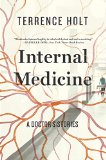Summary | Excerpt | Reviews | Beyond the Book | Readalikes | Genres & Themes | Author Bio

A Doctor's Stories
by Terrence Holt
"What seems to be the problem?" My voice had taken on a strange quality: tight, almost strangled.
"Are you my doctor?"
"I'm the doctor on call," I explained.
"I can't breathe."
I looked at her for a minute.
"What do you mean?"
"I can't . . . catch my breath."
I thought, but nothing brilliant came to mind. "Are you feeling dizzy?" I asked.
"No. Just. Short of breath."
I watched, counting. They were quick, shallow breaths, about twenty-eight of them to the minute.
I bent over her and placed my stethoscope on her back. I heard air moving, in and out, and a faint, light rustling, like clothes brushing together in a darkened closet. "I'll be right back," I said, and left the room to find her nurse. A few minutes later the nurse reported back to me. "Eighty-nine percent." "Is she on any oxygen?" I should know this, I thought. I'd just been looking at her.
The nurse shook her head.
"Put her on two liters and check again."
Ten minutes later the nurse was back. I was in the doctors' workroom, looking up "scleroderma" on the Web.
"Ninety-one percent."
"That's better," I said hopefully.
The nurse shook her head. "Not on two liters. Not how hard she's working."
"You think she's working hard?"
The nurse smiled thinly. "Do you want to check a gas, Doctor?"
I smiled back, genuinely relieved that someone was willing to tell me what to do. "That's a great idea," I said. "Can you do that?"
"No. But you can. I'll get the stuff."
An arterial blood gas is a basic bedside procedure—the kind of thing third-year medical students are encouraged to learn. It involves sticking a needle into an artery and drawing off three or four ccs of blood. The reason a doctor has to draw it is that arteries lie deeper than veins. Even the relatively superficial radial artery—at the wrist, the one you press when checking a pulse—lies a good half-inch deep in most people, and sticking a needle in it stings more than a bit. I was not at that time very skilled at procedures—the arterial blood gas was about the limit of my expertise—but to my relief I had no trouble getting it: bright red blood flashed into the syringe. The patient bore this without a grimace, although by now I wondered if the skin on her face was capable of expression at all. Her eyes regarded the needle in her wrist.
"How are you feeling?"
"A little. Better."
I pulled the needle out, held a pad of gauze to her wrist. She subsided into the bed. "But still. Short of breath."
I watched her. Twenty-six, twenty-eight. Shallow, the muscles at her neck straining with each one.
"I'll be back in a bit," I said, rising with the syringe in my hand. "Call if you need anything." But it's a sign of weakness, I echoed to myself. I hurried on down the hall, the echo following.
While I waited for the lab to process the gas, I skimmed over fifteen pages about scleroderma, a mysterious, untreatable condition in which the skin and organs stiffen. The most feared complications are cardiac and pulmonary. Some victims develop fibrosis of the heart early in the course of the disease and quickly die, as the accumulation of gristle disrupts the heart's conduction system. In the lungs, collagen invades the membranes where the blood exchanges oxygen and carbon dioxide with air: the lungs stiffen, thicken, and fail.
It is possible to get an idea of how this would feel. Putting your head in a paper bag is a dim shadow of it; thick quilts piled high come closer. The difference, of course, is that you can't throw scleroderma off. The bag stays dark; the quilts simply thicken, over years.
The blood gas was not encouraging. The numbers on the screen told me several things. Her blood was acidic. CO2 trapped in her lungs was mixing with water in her blood to make carbonic acid. The acid was chewing up her stores of bicarbonate, which meant that her lungs were getting worse faster than her kidneys could compensate. The really bad news was the amount of oxygen dissolved in her blood, which at a partial pressure of fifty-four millimeters was unusually low, especially for someone getting supplementary O2. Taken together, these numbers spoke of lungs that were rapidly losing access to the outside air.
Excerpted from Internal Medicine: A Doctor's Stories by Terrence Holt. Copyright © 2014 by Terrence Holt. With permission of the publisher, Liveright. All rights reserved.
Your guide toexceptional books
BookBrowse seeks out and recommends the best in contemporary fiction and nonfiction—books that not only engage and entertain but also deepen our understanding of ourselves and the world around us.